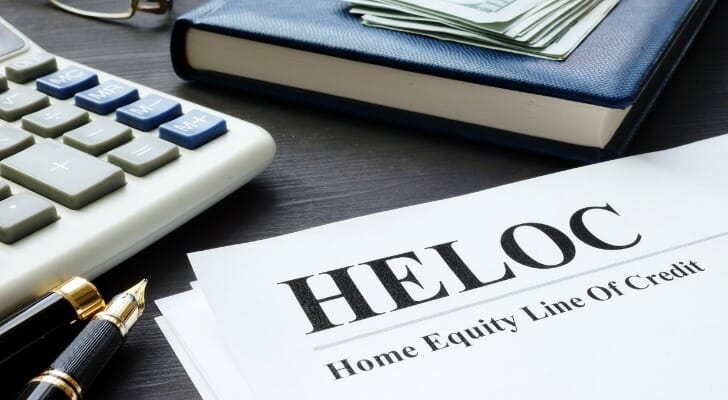To take out a home equity line of credit (a HELOC), you need to have at least 15% to 20% equity in your home. The exact amount depends on your lender and your financial details, such as credit score, debt-to-income ratio and the home’s value. However, most, if not all, will require this as a minimum. This kind of line of credit may be advisable for certain situations but not for all. Consider working with a financial advisor to explore the wisest way for you to benefit from your residence’s equity.
What Is a HELOC?
A HELOC is a line of credit taken out from a bank or other lender and secured by your home. The amount you can receive with this line of credit is based on the value of your home. It is common for people to use this form of borrowing to pay for large purchases, such as renovations, weddings, college tuition or other similar expenses. Most financial advisors recommend only using a HELOC for a long-term value add. For example, remodeling your home or college tuition are both expenses that will create value over the long run, potentially offsetting the money that you will spend on interest payments. General consumer spending such as taking a vacation will not create value, making the HELOC a net loss over time.
A line of credit is similar in function to a credit card. When you take out a simple loan, the lender gives you a one-time amount of cash in exchange for agreed-upon repayment terms. With a line of credit, the lender agrees to loan you up to a given amount on an ongoing basis. So long as you owe less than the maximum on the liner of credit, you can continue to borrow more. When you pay off portions of the existing balance, you can borrow that amount again. This is otherwise known as revolving debt or revolving credit.
Interest rates on home equity lines of credit tend to be lower than most comparable loans. This is because the loan is secured against the borrower’s home. If the borrower defaults on the loan, the lender can take repayment out of the value of the house. In extreme cases this means that the lender can foreclose on the house and force a sale in order to get their money back. However, it is more common for a lender to simply get a lien on the property.
How a HELOC Works
 Unlike a credit card, a HELOC is time-bounded by what is known as the “draw period.” The draw period is the time during which you can borrow from and use your line of credit. A standard HELOC comes with a 10-year draw period. Most loans go into repayment at the end of this draw period.
Unlike a credit card, a HELOC is time-bounded by what is known as the “draw period.” The draw period is the time during which you can borrow from and use your line of credit. A standard HELOC comes with a 10-year draw period. Most loans go into repayment at the end of this draw period.
For example, say you take out a $50,000 line of credit with a 10-year draw period. During those 10 years you can borrow up to $50,000 at any given time. Say that you borrow $40,000 from the line of credit in total. At the end of the draw period you would have to repay the $40,000 that you borrowed plus any applicable interest. With most loans you will not have to begin repaying this principal until the end of the 10-year draw period.
Some HELOCs have additional terms. For example, it is common for the lender to require that you make interest payments during the draw period. Other lenders will set terms on early repayment, although most allow you to repay the principal during the draw period since that gives you more flexibility to borrow over time. Finally, most HELOCs have a repayment period of 10 to 20 years after the draw period, although occasionally a lender will require that you pay off the entire remaining balance in a single payment when the draw period ends.
Home Equity and HELOCs
Home equity is the difference between what you owe on your mortgage (or other property-related debt) and the current value of your house. It is the amount of your house that you own outright, as opposed to the amount of your house that you’re still paying off. Your equity in a property can grow either as you pay off the mortgage, as property values increase due to the housing market or both.
For example, say that your house is worth $500,000 and you still owe $400,000 on your mortgage. You would have $100,000 of equity in this home. Home values are defined variously: The most recent sale price of the property; its assessed tax value as determined by the municipality; or its assessed value as determined by a bank. In the case of a recent purchase, these three values will generally line up. However, the longer it has been since the property was purchased, the more these values will differ. Most lenders will judge home value based on either municipal tax value or their own assessment of the property.
Most lenders require that you have at least 15% to 20% equity in your home before they will extend a line of credit. This means that you must owe less than 80% to 85% of the home’s value. This includes all forms of debt, not only the mortgage but any other secured debt you may have taken out using your home as collateral.
To continue our example, say that your house is worth $500,000. In that case, you would need to owe less than $425,000 on the property before most lenders will consider extending a line of credit.
If you do meet the equity requirements, lenders will almost always extend a loan for a portion of this ownership. It is rare that they will give a loan that covers the full value of the property. Again, from our example above, say that you owe $400,000 on a $500,000 property. This would give you $100,000 in equity. In this case you would likely qualify for a HELOC from most lenders, however, they will almost always offer a line of credit worth some percentage of $100,000, not the total amount.
The Bottom Line
A HELOC is a line of credit secured by the value of your home. To take it out, you must own a minimum amount of your home outright (as opposed to the amount which you still owe on the mortgage). Most lenders require that you owe no more than 80% to 85% of the property’s value before they will approve a HELOC, meaning that you must own at least 15% to 20% of the property free of debt.
Tips on Mortgages
- A home equity line of credit is generally something you want to reserve for major purchases, in large part because the numbers involved will get pretty big. That’s where the insight and guidance of a financial advisor can be tremendously valuable. Finding a qualified financial advisor doesn’t have to be hard. SmartAsset’s free tool matches you with up to three financial advisors who serve your area, and you can interview your advisor matches at no cost to decide which one is right for you. If you’re ready to find an advisor who can help you achieve your financial goals, get started now.
- One of the most practical tools for helping determine if you could benefit from a HELOC is by using our free mortgage calculator.
- The mortgage rate environment is more volatile now than ever. Check out SmartAsset’s mortgage rates table to get a better idea of what the market looks like right now.
- One alternative to a home equity line of credit is a home equity loan. These products give you a lump sum loan secured by an equal interest in your home or other property. If you’re looking at HELOCs, make sure to consider whether a line of credit or a loan is the right product for you.
Photo credit: ©iStock.com/designer491, ©iStock.com/fizkes, ©iStock.com/Prostock-Studio

